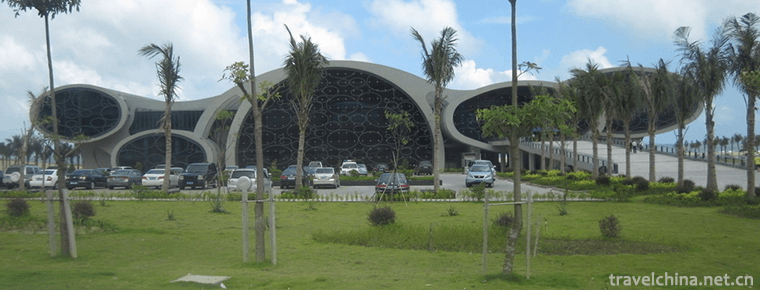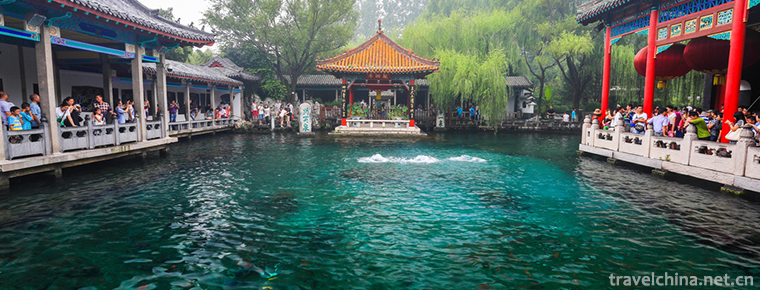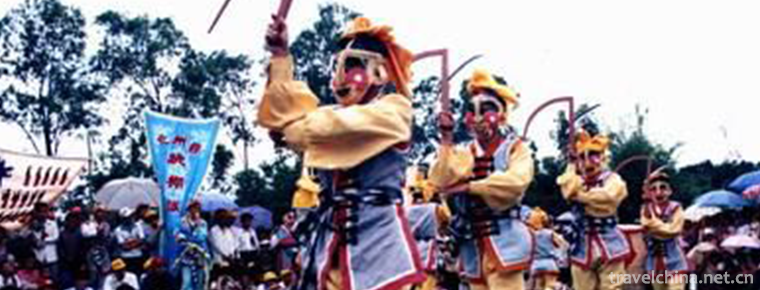Guangdong Marine Silk Road Museum
Guangdong Marine Silk Road Museum
The Guangdong Marine Silk Road Museum is located on the "Shili Silver Beach" of Hailing Island Experimental Development Zone, Yangjiang City, Guangdong Province. The total construction area is 17.5 million square meters. The building is a landmark not only in the country, but also in the world. It is mainly composed of "one Museum and two centers" (Guangdong Marine Silk Road Museum, Marine Silk Road Research Center and R&D Center), with exhibition hall, crystal palace, collection warehouse and other facilities. The main exhibition is the Song Dynasty merchant and trade ships silent at the bottom of the sea for more than 800 years.
Development history
Guangdong Marine Silk Road Museum, also known as Nanhai No. 1 Museum, is located in the west of Shili Yintan Scenic Spot, Hailing Island. It has a pleasant backhill and sea. It laid its foundation on December 28, 2004, officially started construction on December 28, 2005, completed in November 2009, and officially opened to the public on December 24, 2009. The main project is a thematic museum featuring the protection, development and research of ancient sunken ships in the Song Dynasty of "Nanhai I". It exhibits the dynamic demonstration process of the excavation of hydrological and underwater archaeological sites. The cultural relics on board are of great value, and most of them are rare in the world. The total investment of the museum is about 200 million yuan, the total construction land is 129,000 square meters, the control land is 100,000 square meters, and the total construction area is 175,000 square meters. It is elaborately produced by Guangzhou Hanhua Architectural Design Co., Ltd. Its creativity is closely related to the theme of the sea, and its function, structure, form and cultural connotation are highly unified. It is composed of five irregular ellipsoids of different sizes, which are connected in a series. The shape is like the keel of an ancient ship. The whole body is like undulating waves and spreading gulls.
The sunken ship "Nanhai I" in Song Dynasty was unexpectedly discovered by Guangzhou Salvage Bureau and British Ocean Exploration Company in 1987 in the sea area more than 30 nautical miles away from Hailing Island in Yangjiang City. Nanhai No. 1 was a wooden ancient sunken ship in the Southern Song Dynasty. It sank about 20 nautical miles south of Dongping Port, Yangjiang City, Guangdong Province. It is the largest vessel found in the Song Dynasty. In 1987, it was discovered in Yangjiang sea area, Guangdong Province. Preliminary calculation shows that the "Nanhai No. 1" ancient ship is a pointed ship with a length of 30.4 meters and a width of 9.8 meters. Its hull (not counting masts) is about 4 meters high and its drainage is estimated to be 600 tons. Experts speculated from the bow position that the ancient ship was sailing from China to Singapore, India and other Southeast Asian or Middle East countries for overseas trade. Surprisingly, the ancient ship's hull, which had sunk for nearly a thousand years, was well preserved and its wood remained as hard as new. The appearance of this wreck provides the most typical specimen for the study of ancient shipbuilding technology, navigation technology and the scientific law of long-term preservation of wooden cultural relics in China. At the same time, it will also restore the history and ceramics of the maritime Silk Road.
"Nanhai I" is a precious cultural heritage on the main waterway of the "Marine Silk Road". The cultural relics she carries reflect the social production, social life, culture, art and advanced science and technology of the Song Dynasty. It provides excellent materials for the study of ancient shipbuilding technology, navigation technology and ancient "Laixiang Processing" of the "Marine Silk Road Science" and provides excellent materials for the study of "Marine Silk Road Science". The "road" history, shipbuilding history, ceramics history, navigation history, foreign trade history and so on are of great scientific value, and have become the focus of attention in the World Archaeological and exploration circles.
Construction of Guangdong Marine Silk Road Museum started on December 28, 2005. The main project of the museum is composed of five "associated cabins". The Crystal Palace is the largest of the five "associated cabins". The sunken ship of Nanhai I in Song Dynasty is located in the Crystal Palace. Its water depth is 12 meters. The water quality, temperature and environment simulate the artificial synthesis of the submarine environmental parameters of the sunken ship at that time. Construction. On December 23, 2007, "South China Sea I" salvaged water as a whole and entered the museum smoothly on December 28, 2007. At 10:00 a.m. on December 25, 2009, Guangdong Maritime Silk Road Museum, which attracts much attention, was opened facing the sea. The grand opening ceremony was held in the "Nanhai No. 1" Museum Square of Shili Yintan, Hailing Island. Since then, the history of China's large underwater archaeological museum has been rewritten again.
Guangdong China Maritime Silk Road Museum will become a modern professional underwater museum with the starting point of "cultural relics protection, coordination of environment and tourism development", the core of which is cultural relics protection, the principle of paying attention to environment and ecological protection, and the goal of "hiding cultural connotations, implying the idea of the times, and integrating natural charm". The museum is surrounded by entertainment city, diving club, sailing club, hotel, sea bathing area, sea cultural performance square and tourist entertainment commercial street and other ancillary facilities. The design of the project will strictly abide by the principles of taking the protection of cultural relics as the core, paying attention to the protection of environment and ecology, and ensuring that it will be matched with the main body of the museum after completion.
Collection
Sunflower Plate Printed with Green and White Glaze in Jingdezhen Kiln
Chrysanthemum petal-shaped mouth, folded abdomen, the overall impression is sunflower petal-shaped. Green and white glaze, glaze color crystal. A flower pattern is printed on the bottom of the dish.
Chrysanthemum petal plate carved with blue glaze in Longquan kiln
Chrysanthemum petal mouth, the inner wall of the chrysanthemum petal pattern, like "out of the tendons", engraved a group of chrysanthemum heart. Shiqing glaze, thick and lustrous glaze, thick glaze layer, like water in the plate.
Golden Dragon Ring
Qilong is a winding dragon. In ancient legends, scales are called Jiaolong, wings are called Yinglong, horns are called Qilong and hornless are called Chilong. The two ends of the ring are decorated with dragon heads. A pair of longan, dragon whisker and dragon horn can be seen. There is a gap between the two ends. The cross section of the ring has a cylindrical protrusion. The dragon body is divided into five segments by three negative lines, and the five segments are connected by two parallel negative lines. The dragon body is decorated with pearl ground pattern, and the two sides of the parallel line are mountain and water patterns.
Brown plum bottle in magnetic stove kiln
Small mouth, oblique straight abdomen, mouth along the application of a week of paste glaze, the rest unglazed, plain tire. Matrix gray, sandy, rough, leaving strings in the matrix when drawing, is a container for liquid.
Rabbit's hair
Black glaze was applied inside and outside, and white radial stripes appeared in the bowl, which was like rabbit hair. The glaze color is kiln glaze, black and tea final color blend. The color is rich in changes and the charm is unique. This is the product of the Song Dynasty tea fighting.
Travel Tips
Ticket information
1. Children under 120 cm height are free to visit.
2. Older people over 70 years old are free to visit with their valid ID cards.
3. Older people aged 60 to 69 buy half-price tickets with valid ID cards.
4. Full-time students buy half-price tickets on the basis of student certificates.
5. Chinese citizens with active service and disability certificates are free to visit.
Traffic information
1. Ways: Guangzhou-S81 Ring City Expressway (17 km) - Beijiang Dadi/Guangfo Expressway/Zhaoqing/Lishui/Kaiping/Shabei (Exit) - G15 Guangfo Expressway (14.2 km) - G15 Fokai Expressway (81 km) - G15 Kaiyang Expressway (124 km) - 277 Provincial Highway - Hailing Island
Time required: about 4.5 hours
2. Ways: Shenzhen-G4 Guangshen Expressway (51.3 km) - G9411 Guanfo Expressway (18.8 km) - G4W Beijing-Zhuhai Expressway - S2 6 Jiangjiang Expressway (58 km) - G15 Fokai Expressway (19.6 km) - G15 Kaiyang Expressway (124 km) - 277 Provincial Highway - Hailing Island
Time required: about 5.5 hours
Specialty food
Steamed eggs, wrasses, shrimps and scallops are its signature dishes in Zhapo New Town Fishery Sauce. They are delicious and fragrant after eating. You are lucky to visit the Guangdong Maritime Silk Road Museum. You must not miss the delicious food here.


-
Red Cooked Chicken Daokou Style
Red-Cooked Chicken, Daokou Style is one of the traditional specialties. It is made by Yixing Zhang family roast chicken shop in Daokou Town, Huaxian County, Henan Province.
Views: 236 Time 2018-11-26 -
Jinan World First Spring Scenic Area
Jinan World No. 1 Spring Scenic Area, located in the center of Jinan City, Shandong Province, is a national AAAAA-level tourist attraction, national key park, advanced unit of national spiritual civil.
Views: 186 Time 2018-12-08 -
Peace Hotel Shanghai
Peace Hotel is a landmark building in Shanghai. Located at No. 20 East Nanjing Road, Huangpu District, Shanghai, it is the first modern building in the history of modern architecture in Shanghai.
Views: 372 Time 2018-12-16 -
Nanzhao Custom Island Dali
Nanzhao Custom Island in Dali is one of the three islands in Erhai Lake, located in Shuanglang Township at the southeast end of Eryuan County, the golden section of Cang Er National Scenic Area.
Views: 159 Time 2019-01-06 -
Thrush valley ecological tourist area
Thrushcross Valley is a natural eco-tourism area, located in Yaoshan Town, Lushan County, Henan Province, and at the northern foot of Yaoshan Scenic Area. It is a national AAAA-level tourist attractio.
Views: 155 Time 2019-01-17 -
Acrobatics in Dongbeizhuang
Dongbeizhuang acrobatics is a traditional folk acrobatics in Puyang City. Dongbeizhuang, Yuecun Township in Puyang City, is a pearl in the vast plain of northern Henan Province.
Views: 111 Time 2019-04-27 -
Flower hopping shed
Dancing Huapeng, introduced from Fujian in Ming Dynasty, is an ancient traditional folk dance, belonging to Nuo dance. It has a fixed "Keben" (singing desk book), which is divided into 18 br.
Views: 247 Time 2019-06-21 -
Month also
Dong people's "moon" means collective visiting, which is a social custom in Dong village. The young men and women in one village of the Dong nationality visit another village according to th.
Views: 329 Time 2019-07-16 -
Civil Aviation Flight University Of China
The school is directly under the Civil Aviation Administration of China. Its predecessor was established in May 1956 with the approval of Premier Zhou Enlai. Chairman Mao Zedong appointed the aviation.
Views: 175 Time 2019-08-31 -
Former site of Brazil Conference
The former site of the Brazil conference, formerly known as Banyou temple, is located in Brazil township of Zoige county (which belonged to Songpan County before 1956) at the southeast border of Aba Prefecture and Gansu Province. It is near the edge of grassland and is a semi agricultural and semi pastoral Tibetan inhabited area, 32 kilometers east of Zoige county. .
Views: 95 Time 2020-11-07 -
Leshan social service
By the end of 2018, there were 13 social welfare homes in Leshan City with 2908 beds and 2182 people in the hospital. The sales of social welfare lottery tickets totaled 385.69 million yuan, raised 109.75 million yuan of welfare lottery public welfare fund,.
Views: 162 Time 2020-12-17










